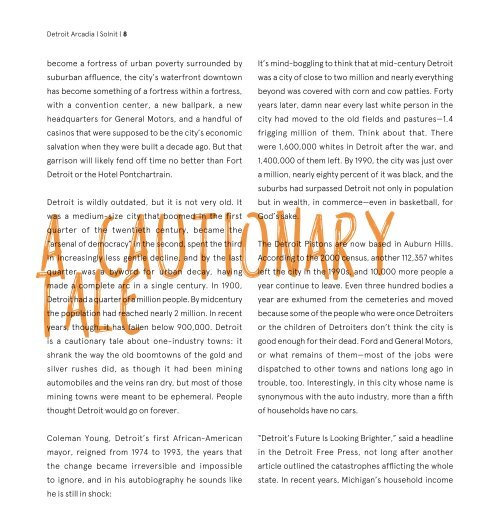Detroit Arcadia
Create successful ePaper yourself
Turn your PDF publications into a flip-book with our unique Google optimized e-Paper software.
<strong>Detroit</strong> <strong>Arcadia</strong> | Solnit | 8<br />
become a fortress of urban poverty surrounded by It’s mind-boggling to think that at mid-century <strong>Detroit</strong><br />
suburban affluence, the city’s waterfront downtown was a city of close to two million and nearly everything<br />
has become something of a fortress within a fortress, beyond was covered with corn and cow patties. Forty<br />
with a convention center, a new ballpark, a new years later, damn near every last white person in the<br />
headquarters for General Motors, and a handful of city had moved to the old fields and pastures—1.4<br />
casinos that were supposed to be the city’s economic frigging million of them. Think about that. There<br />
salvation when they were built a decade ago. But that were 1,600,000 whites in <strong>Detroit</strong> after the war, and<br />
garrison will likely fend off time no better than Fort 1,400,000 of them left. By 1990, the city was just over<br />
<strong>Detroit</strong> or the Hotel Pontchartrain.<br />
a million, nearly eighty percent of it was black, and the<br />
suburbs had surpassed <strong>Detroit</strong> not only in population<br />
A<br />
<strong>Detroit</strong> is wildly<br />
CAUTIONARY<br />
outdated, but it is not very old. It but in wealth, in commerce—even in basketball, for<br />
was a medium-size city that boomed in the first God’s sake.<br />
quarter of the twentieth century, became the<br />
“arsenal of democracy” in the second, spent the third The <strong>Detroit</strong> Pistons are now based in Auburn Hills.<br />
in increasingly less gentle decline, and by the last According to the 2000 census, another 112,357 whites<br />
TALE<br />
quarter was a byword for urban decay, having left the city in the 1990s, and 10,000 more people a<br />
made a complete arc in a single century. In 1900, year continue to leave. Even three hundred bodies a<br />
<strong>Detroit</strong> had a quarter of a million people. By midcentury year are exhumed from the cemeteries and moved<br />
the population had reached nearly 2 million. In recent because some of the people who were once <strong>Detroit</strong>ers<br />
years, though, it has fallen below 900,000. <strong>Detroit</strong> or the children of <strong>Detroit</strong>ers don’t think the city is<br />
is a cautionary tale about one-industry towns: it good enough for their dead. Ford and General Motors,<br />
shrank the way the old boomtowns of the gold and or what remains of them—most of the jobs were<br />
silver rushes did, as though it had been mining dispatched to other towns and nations long ago in<br />
automobiles and the veins ran dry, but most of those trouble, too. Interestingly, in this city whose name is<br />
mining towns were meant to be ephemeral. People synonymous with the auto industry, more than a fifth<br />
thought <strong>Detroit</strong> would go on forever.<br />
of households have no cars.<br />
Coleman Young, <strong>Detroit</strong>’s first African-American<br />
mayor, reigned from 1974 to 1993, the years that<br />
the change became irreversible and impossible<br />
to ignore, and in his autobiography he sounds like<br />
he is still in shock:<br />
“<strong>Detroit</strong>’s Future Is Looking Brighter,” said a headline<br />
in the <strong>Detroit</strong> Free Press, not long after another<br />
article outlined the catastrophes afflicting the whole<br />
state. In recent years, Michigan’s household income






